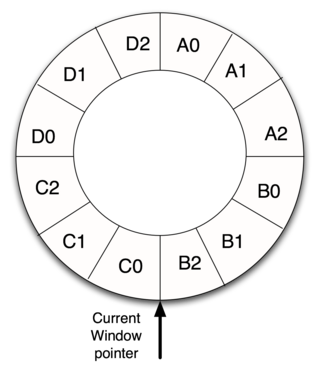Related Research Articles

Alpha is a 64-bit reduced instruction set computer (RISC) instruction set architecture (ISA) developed by Digital Equipment Corporation (DEC). Alpha was designed to replace 32-bit VAX complex instruction set computers (CISC) and to be a highly competitive RISC processor for Unix workstations and similar markets.
MMIX is a 64-bit reduced instruction set computing (RISC) architecture designed by Donald Knuth, with significant contributions by John L. Hennessy and Richard L. Sites. Knuth has said that,
MMIX is a computer intended to illustrate machine-level aspects of programming. In my books The Art of Computer Programming, it replaces MIX, the 1960s-style machine that formerly played such a role… I strove to design MMIX so that its machine language would be simple, elegant, and easy to learn. At the same time I was careful to include all of the complexities needed to achieve high performance in practice, so that MMIX could in principle be built and even perhaps be competitive with some of the fastest general-purpose computers in the marketplace."

In electronics and computer science, a reduced instruction set computer (RISC) is a computer architecture designed to simplify the individual instructions given to the computer to accomplish tasks. Compared to the instructions given to a complex instruction set computer (CISC), a RISC computer might require more instructions in order to accomplish a task because the individual instructions are written in simpler code. The goal is to offset the need to process more instructions by increasing the speed of each instruction, in particular by implementing an instruction pipeline, which may be simpler to achieve given simpler instructions.

SPARC is a reduced instruction set computer (RISC) instruction set architecture originally developed by Sun Microsystems. Its design was strongly influenced by the experimental Berkeley RISC system developed in the early 1980s. First developed in 1986 and released in 1987, SPARC was one of the most successful early commercial RISC systems, and its success led to the introduction of similar RISC designs from many vendors through the 1980s and 1990s.
In computer science, an instruction set architecture (ISA) is an abstract model that generally defines how software controls the CPU in a computer or a family of computers. A device or program that executes instructions described by that ISA, such as a central processing unit (CPU), is called an implementation of that ISA.
ARM is a family of RISC instruction set architectures (ISAs) for computer processors. Arm Ltd. develops the ISAs and licenses them to other companies, who build the physical devices that use the instruction set. It also designs and licenses cores that implement these ISAs.
The Motorola 68000 series is a family of 32-bit complex instruction set computer (CISC) microprocessors. During the 1980s and early 1990s, they were popular in personal computers and workstations and were the primary competitors of Intel's x86 microprocessors. They were best known as the processors used in the early Apple Macintosh, the Sharp X68000, the Commodore Amiga, the Sinclair QL, the Atari ST and Falcon, the Atari Jaguar, the Sega Genesis and Sega CD, the Philips CD-i, the Capcom System I (Arcade), the AT&T UNIX PC, the Tandy Model 16/16B/6000, the Sun Microsystems Sun-1, Sun-2 and Sun-3, the NeXT Computer, NeXTcube, NeXTstation, and NeXTcube Turbo, early Silicon Graphics IRIS workstations, the Aesthedes, computers from MASSCOMP, the Texas Instruments TI-89/TI-92 calculators, the Palm Pilot, the Control Data Corporation CDCNET Device Interface, the VTech Precomputer Unlimited and the Space Shuttle. Although no modern desktop computers are based on processors in the 680x0 series, derivative processors are still widely used in embedded systems.

PIC is a family of microcontrollers made by Microchip Technology, derived from the PIC1640 originally developed by General Instrument's Microelectronics Division. The name PIC initially referred to Peripheral Interface Controller, and is currently expanded as Programmable Intelligent Computer. The first parts of the family were available in 1976; by 2013 the company had shipped more than twelve billion individual parts, used in a wide variety of embedded systems.

In computer engineering, register windows are a feature which dedicates registers to a subroutine by dynamically aliasing a subset of internal registers to fixed, programmer-visible registers. Register windows are implemented to improve the performance of a processor by reducing the number of stack operations required for function calls and returns. One of the most influential features of the Berkeley RISC design, they were later implemented in instruction set architectures such as AMD Am29000, Intel i960, Sun Microsystems SPARC, and Intel Itanium.
Addressing modes are an aspect of the instruction set architecture in most central processing unit (CPU) designs. The various addressing modes that are defined in a given instruction set architecture define how the machine language instructions in that architecture identify the operand(s) of each instruction. An addressing mode specifies how to calculate the effective memory address of an operand by using information held in registers and/or constants contained within a machine instruction or elsewhere.
In computer engineering, out-of-order execution is a paradigm used in high-performance central processing units to make use of instruction cycles that would otherwise be wasted. In this paradigm, a processor executes instructions in an order governed by the availability of input data and execution units, rather than by their original order in a program. In doing so, the processor can avoid being idle while waiting for the preceding instruction to complete and can, in the meantime, process the next instructions that are able to run immediately and independently.
A branch, jump or transfer is an instruction in a computer program that can cause a computer to begin executing a different instruction sequence and thus deviate from its default behavior of executing instructions in order. Branch may also refer to the act of switching execution to a different instruction sequence as a result of executing a branch instruction. Branch instructions are used to implement control flow in program loops and conditionals.
The TMS9900 was one of the first commercially available, single-chip 16-bit microprocessors. Introduced in June 1976, it implemented Texas Instruments' TI-990 minicomputer architecture in a single-chip format, and was initially used for low-end models of that lineup.

The AMD Am29000, commonly shortened to 29k, is a family of 32-bit RISC microprocessors and microcontrollers developed and fabricated by Advanced Micro Devices (AMD). Based on the seminal Berkeley RISC, the 29k added a number of significant improvements. They were, for a time, the most popular RISC chips on the market, widely used in laser printers from a variety of manufacturers.

The Clipper architecture is a 32-bit RISC-like instruction set architecture designed by Fairchild Semiconductor. The architecture never enjoyed much market success, and the only computer manufacturers to create major product lines using Clipper processors were Intergraph and High Level Hardware, although Opus Systems offered a product based on the Clipper as part of its Personal Mainframe range. The first processors using the Clipper architecture were designed and sold by Fairchild, but the division responsible for them was subsequently sold to Intergraph in 1987; Intergraph continued work on Clipper processors for use in its own systems.
The Atmel AVR instruction set is the machine language for the Atmel AVR, a modified Harvard architecture 8-bit RISC single chip microcontroller which was developed by Atmel in 1996. The AVR was one of the first microcontroller families to use on-chip flash memory for program storage.
In computer science, a calling convention is an implementation-level (low-level) scheme for how subroutines or functions receive parameters from their caller and how they return a result. When some code calls a function, design choices have been taken for where and how parameters are passed to that function, and where and how results are returned from that function, with these transfers typically done via certain registers or within a stack frame on the call stack. There are design choices for how the tasks of preparing for a function call and restoring the environment after the function has completed are divided between the caller and the callee. Some calling convention specifies the way every function should get called. The correct calling convention should be used for every function call, to allow the correct and reliable execution of the whole program using these functions.
A stack register is a computer central processor register whose purpose is to keep track of a call stack. On an accumulator-based architecture machine, this may be a dedicated register. On a machine with multiple general-purpose registers, it may be a register that is reserved by convention, such as on the IBM System/360 through z/Architecture architecture and RISC architectures, or it may be a register that procedure call and return instructions are hardwired to use, such as on the PDP-11, VAX, and Intel x86 architectures. Some designs such as the Data General Eclipse had no dedicated register, but used a reserved hardware memory address for this function.
In computer programming, a function, procedure, method, subroutine, routine, or subprogram is a callable unit of software logic that has a well-defined interface and behavior and can be invoked multiple times.
RISC-V is an open standard instruction set architecture (ISA) based on established reduced instruction set computer (RISC) principles. Unlike most other ISA designs, RISC-V is provided under royalty-free open-source licenses. Many companies are offering or have announced RISC-V hardware; open source operating systems with RISC-V support are available, and the instruction set is supported in several popular software toolchains.
References
- ↑ "ARMv7-M Architecture Reference Manual". ARM . Retrieved 24 August 2022.
- ↑ "ARMv7-A and ARMv7-R Architecture Reference Manual; Arm Holdings". arm.com. Retrieved 24 August 2022.
- ↑ "Using as, section 9.33.1.2 (OPENRISC Dependent Features/Register Names)" . Retrieved 25 August 2022.
- ↑ "RTEMS SPARC Applications Supplement" (PDF). May 2000. Archived from the original (PDF) on 8 January 2019. Retrieved 2013-04-19.
- 1 2 "Using as, section 9.3.2.2 (ARC Dependent Features/Syntax/Register Names)" . Retrieved 25 August 2022.
- ↑ "ARC Synopsys DesignWare ARCv2 System V ABI Supplement" (PDF). Archived (PDF) from the original on 25 August 2022. Retrieved 25 August 2022.
- 1 2 "ARCompact Instruction Set Architecture Programmer's Reference" (PDF). April 2008. Archived (PDF) from the original on 9 June 2022. Retrieved 25 August 2022.
- ↑ "ARCtangent-A4 Programmer's Reference" (PDF). August 2002. Archived (PDF) from the original on 8 March 2022. Retrieved 25 August 2022.
- ↑ "Lauterbach". Archived from the original on 1 May 2016. Retrieved 25 August 2022.